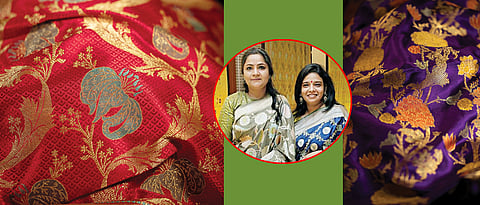

India’s hand-weaving tradition is known to all. Hand-woven sarees, dupattas, shawls, which we may have inherited from our mothers and grandmothers, are part of our rich culture. This legacy needs to be passed down to the next generation.
Kolkata-based designers Swati Agarwal and Sunaina Jalan, who launched their label Swati & Sunaina in 2007, are committed towards reviving India’s forgotten handloom weaves. The designers undertook a lot of research to create luxurious sarees embellished with intricate zari and vibrant floral work. The historic gold and silver brocades with which Tibetan robes were made, have been revived and turned into Banarasi sarees by the designers. At the AD Design Show 2019 in Mumbai, the duo showcased these exquisite, rich weaves.
Taking inspiration from the gyaser, which is a Tibetan word for a variety of richly patterned silk-brocade fabrics, Agarwal says, “When a gyaser is worn or used in a space, it is meant to embrace the person or place with blessings.” In recent years, both the designers have been reviving this tradition to create sarees, handwoven over several months on pit looms in Varanasi, using zari made with 98.5 per cent silver and plated with 24 carat gold. “With gyaser we see rare skills and techniques that go into the making of this exquisite object of tradition and beauty, so it is a variety of silk-brocade fabric, characterised by the use of gold and silver threads, richly patterned with Buddhist and Chinese symbols for long life, protection and prosperity, which makes the collection very special for many reasons,” she adds.
To create something special is not easy. Unsurprisingly, there were many challenges for the designers. Most importantly, this weave was never used to create textiles for sarees. “We worked for a few years to make gyaser weave suitable to be draped as a saree,” Agarwal mentions.
Keeping the inherent qualities and visual aesthetics of the fabric intact, Jalan says that they tried to bring out the boldness and expressiveness of the traditional gyaser in a new idiom, and for the first time adapted the gyaser weave into sarees.
Talking about the origin of the weave, the designers point out that gyaser is the story of the other silk route, from Varanasi to the Himalayas and is made of different traditions, cultures, fabrics and threads. “Monasteries are elaborately and sumptuously decorated with gyaser fabric and the prestige of gyaser, its rarefied quality and the special process of woven gold make it a luxury textile in the truest sense,” says Jalan.
The story began in Varanasi where weavers would sit down on their pit looms and meticulously create a piece of gyaser fabric. Jalan says that the story follows through the mighty Himalayas to the monasteries in Ladakh and other Buddhist land in the neighbouring places. “In between all of this is the story of Kalimpong, a town that was a large commercial market on the trade route between India and Tibet. Many traders from neighbouring regions like China, Tibet, India, Nepal, Bhutan etc would show and sell their goods there,” says Jalan.
Traditionally, gyasar was woven in patterns that had religious connotations in the Buddhist culture like the lotus, dragon or lightning. “However , we have retained the Oriental feel by using various Oriental flowers instead of religious symbols. Handloom fabric is a luxury now as there are very few skilled craftsmen who can actually weave and even a lesser number of people who want to become weavers because of which there is a surge in powerloom production due to its ease of handling and pace of production,” says Jalan.
But will the powerloom wipe out the legacy of the gyaser? “Not really,” says Agarwal adding that the gyasar is technically complex to weave. “We are hoping to give it a new lease of life with our intervention. Even if the powerloom picks up owing to its popularity, the form of gyaser produced in a powerloom will be similar only in terms of the patterns used and will be far more generic and simplified in technique,” adds Agarwal. The beauty of a human touch versus a mechanised form cannot be compared.
The luxury textiles of woven gold in gyaser tradition presented by Swati and Sunaina are truly special for some of the following reasons: A special zari is created in pure silver 98.5 per cent purity (highest form possible) and electroplated with 24 carat gold to achieve the bright tone required in a gyaser textile. “For a few years now, we have been working with master weavers to re-introduce pure zari in interpretations of classic designs in Varanasi which has involved studying how such zari is made, a tradition kept alive by the last such atelier in the city,” says Jalan.
They looked at gyaser for inspiration and for the first time ever attempted to recreate its magic in sarees. Traditionally gyaser, given its thickness of fabric, can only be woven in narrow width and short length (width not surpassing 60 to 70 centimetres) so the multiple challenges included reducing the weight, increasing the width and modifying the construction of the textile to make it light and supple and while retaining the original character of these bold and impressive textiles. “Gyaser is amongst the most prestigious of fabrics and is a luxury textile valued by textile connoisseurs and collectors. A rich heritage after all,” Jalan concludes.
